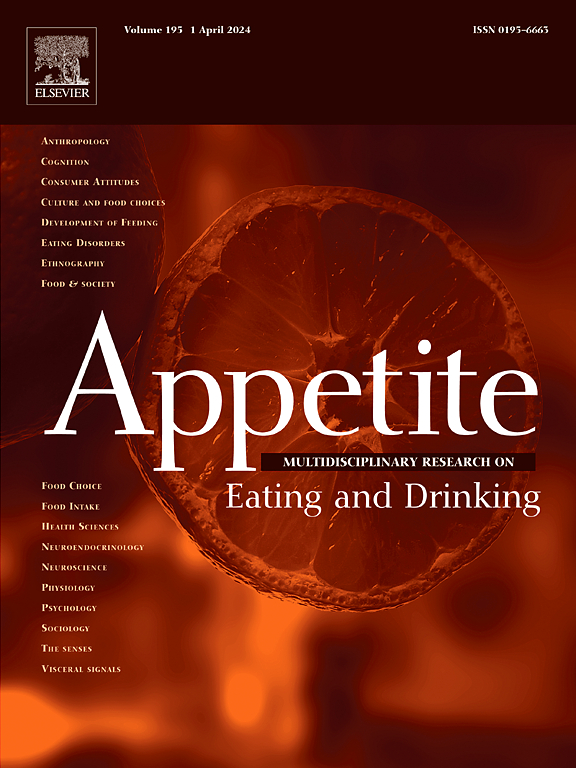Effects of apple form on satiety in 4–6 year-old children: possible evidence of sex differences
IF 3.8
2区 医学
Q1 BEHAVIORAL SCIENCES
引用次数: 0
Abstract
Research in adults has shown that food form (e.g., liquid, semi-solid, solid) influences satiety, even when energy and energy density are matched. However, less is known about the impact of food form on satiety in children. We examined the influence of food form on children's subsequent meal intake. Children (n = 64, F = 32; mean age 5.9 years-old) completed a crossover study with 5 laboratory visits, each ∼1 week apart. During each visit, children were presented with no preload (control) or one of 4 apple preloads: slices, purée, juice, or juice sweetened with non-nutritive sweetener. Apple slices, purée, and juice were matched for energy and energy density. Visual cues were masked and eating rate was controlled. The order of conditions was pseudorandomized and counterbalanced. Following the preload, children ate ad libitum from a standardized meal and satiety was calculated as the % of energy intake at the preload + meal relative to intake at the no preload condition (100 % = perfect compensation). Food form did not influence satiety. Satiety was 112 %, 121 %, and 120 % for apple slices, purée, and juice, respectively (p > 0.05). Results, however, varied by sex: boys showed near perfect (99 %) compensation for apple slices (p < 0.01), while it was 125 % in girls. Compared to the control condition, satiety in boys was better (i.e., closer to 100 %) than in girls (p < 0.05). Thus, when visual cues were masked and consumption rate controlled, solid fruit and fruit juice had similar effects on satiety, but across fruit forms, boys showed better satiety than girls. These findings suggest that factors that influence satiety differ by child sex; we posit that satiety in girls may be driven more by social/learned cues while boys respond to biological signals.
苹果形状对4-6岁儿童饱腹感的影响:性别差异的可能证据。
对成人的研究表明,即使能量和能量密度相匹配,食物形式(如液体、半固体、固体)也会影响饱腹感。然而,人们对食物形式对儿童饱腹感的影响知之甚少。我们研究了食物形式对儿童随后膳食摄入量的影响。儿童(n=64, F=32;平均年龄5.9岁)完成了5次实验室访问的交叉研究,每次间隔1周。在每次访问中,孩子们都没有预负荷(对照组)或四种预负荷中的一种:切片、苹果酱、果汁或用非营养性甜味剂加糖的果汁。苹果片、芒果和果汁的能量和能量密度是匹配的。视觉线索被掩盖,进食速度被控制。条件的顺序是伪随机和平衡的。在预负荷后,儿童从标准化的膳食中随意进食,饱腹感被计算为预负荷+膳食时摄入的能量与无预负荷条件下摄入的能量的百分比(100% =完美补偿)。食物形式不影响饱腹感。苹果片、苹果酱和果汁的饱腹率分别为112%、121%和120% (p < 0.05)。然而,结果因性别而异:男孩对苹果片的补偿接近完美(99%)
本文章由计算机程序翻译,如有差异,请以英文原文为准。
求助全文
约1分钟内获得全文
求助全文
来源期刊

Appetite
医学-行为科学
CiteScore
9.10
自引率
11.10%
发文量
566
审稿时长
13.4 weeks
期刊介绍:
Appetite is an international research journal specializing in cultural, social, psychological, sensory and physiological influences on the selection and intake of foods and drinks. It covers normal and disordered eating and drinking and welcomes studies of both human and non-human animal behaviour toward food. Appetite publishes research reports, reviews and commentaries. Thematic special issues appear regularly. From time to time the journal carries abstracts from professional meetings. Submissions to Appetite are expected to be based primarily on observations directly related to the selection and intake of foods and drinks; papers that are primarily focused on topics such as nutrition or obesity will not be considered unless they specifically make a novel scientific contribution to the understanding of appetite in line with the journal's aims and scope.
 求助内容:
求助内容: 应助结果提醒方式:
应助结果提醒方式:


